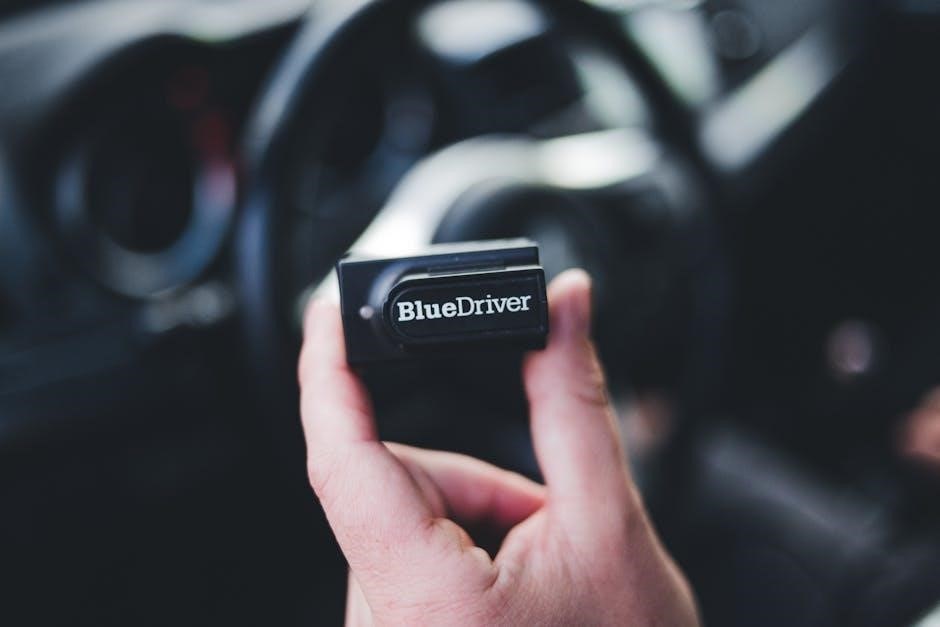
Welcome to the LS2208 Barcode Scanner Manual, your comprehensive guide to understanding and optimizing the Zebra Symbol LS2208 scanner. This manual provides detailed instructions for setup, configuration, and troubleshooting to ensure efficient and reliable scanning experiences across various applications.
1.1 Overview of the LS2208 Barcode Scanner
The Zebra Symbol LS2208 is a reliable and versatile laser barcode scanner designed for efficient decoding of various barcode symbologies, including PC/EAN, UPC/EAN, Code 39, and GS1 DataBar. Its ergonomic design ensures user comfort during extended scanning sessions, while the audio feedback feature enhances user confidence by confirming successful scans. The scanner supports multiple interfaces, such as RS-232 and Keyboard Wedge, making it compatible with a wide range of host devices. Ideal for retail, healthcare, and inventory management, the LS2208 offers robust performance and ease of use, making it a valuable tool for streamlining barcode scanning operations in diverse environments.
1.2 Importance of the Manual for Users
This manual is essential for users to maximize the functionality and efficiency of the LS2208 barcode scanner. It provides step-by-step instructions for setting up, configuring, and troubleshooting the device, ensuring a smooth and seamless scanning experience. The guide covers critical features such as programming the scanner for specific applications, enabling keyboard emulation, and adding carriage returns after scans. By following the manual, users can optimize the scanner’s performance, resolve common issues, and maintain its longevity. Whether for retail, healthcare, or inventory management, this manual empowers users to harness the full potential of the LS2208, enhancing productivity and accuracy in their daily operations.

Product Specifications and Features
The LS2208 offers advanced scanning capabilities, supporting multiple barcode symbologies, ergonomic design for user comfort, and audio feedback for efficient operation.
2.1 Supported Barcode Symbologies
The LS2208 supports a wide range of barcode symbologies, including PC/EAN, UPC/EAN, UCC/EAN 128, Code 39, Code 39 ASCII, Code 39 TriOptic, Code 128, Code 128 ASCII, Codabar, 2 of 5, Code 93, MSI, Code 11, IATA, and GS1 DataBar. This versatility ensures compatibility with various industries and applications, making it a reliable choice for scanning diverse barcode types efficiently. The scanner’s ability to decode multiple symbologies enhances its functionality across different environments, from retail to healthcare, ensuring accurate and seamless data capture.
2.2 Scanner Interfaces (RS-232, Keyboard Wedge)
The LS2208 scanner supports two primary interfaces: RS-232 and Keyboard Wedge, ensuring flexibility in connecting to various host devices. The RS-232 interface provides a standard serial connection, enabling reliable communication with systems that require a direct serial port setup. Meanwhile, the Keyboard Wedge interface allows the scanner to emulate a keyboard, sending scanned data as keystrokes directly to the host device. This eliminates the need for additional software, making it ideal for systems that accept keyboard input. Both interfaces enhance versatility, catering to different operational needs and ensuring seamless integration into various environments.
2.3 Ergonomic Design and User Comfort
The LS2208 scanner is designed with ergonomics in mind, offering a comfortable grip and balanced weight distribution to minimize user fatigue. Its contoured shape fits naturally in the hand, reducing strain during extended scanning sessions. The lightweight construction ensures ease of use, making it suitable for high-volume scanning environments. The ergonomic design prioritizes user comfort, enabling efficient and accurate scanning over long periods without discomfort. This focus on usability ensures the LS2208 remains a practical choice for diverse workplace settings, promoting productivity and reducing the risk of repetitive strain injuries.
2.4 Audio Feedback for User Efficiency
The LS2208 incorporates an audio feedback system to enhance user efficiency. It provides distinct tones to indicate successful scans, low battery warnings, and error notifications. This feature ensures users can operate the scanner without needing to visually monitor it, streamlining workflows and reducing downtime. The audible signals allow for quick confirmation of scans, enabling seamless integration into various applications. This intuitive feedback mechanism improves accuracy and user confidence, making the LS2208 a reliable tool for efficient barcode scanning in fast-paced environments. The audio cues are customizable, allowing users to tailor the feedback to their specific needs.

Unpacking and Initial Setup
Unpack your LS2208 scanner carefully, ensuring all components are included. Connect it to your host device, install the necessary drivers, and refer to the quick start guide for seamless setup.
3.1 Unpacking Your LS2208 Scanner
When unpacking your LS2208 scanner, carefully inspect the contents to ensure all components are included. Verify the scanner, interface cable, and any additional accessories are present. Check for visible damage or defects. Gently remove the scanner from its packaging and handle it with care to avoid scratching the lens or casing. Ensure the scanner is clean and free from debris before initial use. Refer to the quick start guide for a detailed list of included items. If any components are missing or damaged, contact your supplier immediately. Proper handling ensures optimal performance and longevity of your LS2208 scanner.
3.2 Connecting the Scanner to Your Host Device
Connecting the LS2208 scanner to your host device is straightforward and ensures seamless communication. For RS-232 connections, use the provided cable to link the scanner to a serial port. If using Keyboard Wedge, plug the scanner into a free USB port, and it will emulate keyboard input. USB connections are plug-and-play, with drivers installing automatically. Verify the scanner powers on and audio feedback confirms connectivity. For host communication, scan the appropriate barcodes in the manual to select the correct port (e.g., Non-IBM, Hand-Held, or Table-Top emulation). Test scanning to ensure data transmission works correctly. If issues arise, refer to troubleshooting guidelines or reconnect the scanner.
3.3 Installing Scanner Drivers and Software
Installing the LS2208 scanner drivers and software is essential for optimal functionality; Begin by downloading the latest drivers from the official Zebra website or use the CD provided. Run the installer, following on-screen prompts to complete the installation. Ensure the scanner is connected to your host device via USB or RS-232 before installing; Once installed, the scanner will be recognized by your system. For advanced configurations, use the 123Scan utility to customize settings. Restart your system after installation to ensure all drivers are properly loaded. This step ensures compatibility and enables features like HID keyboard emulation and single-digit barcode applications, enhancing your scanning experience.

Programming and Configuration
This section guides you through programming and configuring the LS2208 scanner for specific applications. Learn to set defaults, enable HID emulation, and customize scanning behaviors for optimal performance in your environment.
4.1 Setting the Scanner to Default Settings
Resetting the LS2208 scanner to its default settings is essential for initializing or troubleshooting. To do this, scan the “Reset to Defaults” barcode found in the manual. This action restores factory settings, erasing any custom configurations. Ensure the scanner is in a stable state before proceeding. After resetting, the scanner will revert to its original emulation mode and default parameters. Note that this process may require reconnecting the scanner to your host device. For detailed steps, refer to the manual or the 123Scan configuration program. Always reboot the scanner after resetting to ensure changes take effect. This step is crucial for maintaining optimal performance and compatibility.
4.2 Enabling HID Keyboard Emulation
To enable HID Keyboard Emulation on the LS2208 scanner, scan the “HID Keyboard Emulation” barcode from the manual. This mode allows the scanner to mimic keyboard input, sending scanned data directly to any text field. Ensure the host device supports HID emulation and is properly connected. After scanning, the scanner will transmit data as keystrokes, enabling seamless integration with applications. For additional customization, such as adding a carriage return, refer to the manual’s programming section. This feature enhances efficiency, especially in environments requiring direct data entry without additional software. Always test the scanner after enabling this mode to confirm proper functionality.
4.3 Configuring the Scanner for Single-Digit Barcode Applications
To configure the LS2208 scanner for single-digit barcode applications, start by resetting the scanner to its default settings using the “Defaults” barcode in the manual. This ensures a clean configuration. Next, scan the “Single-Digit Barcode Enablement” barcode to restrict the scanner to reading only single-digit barcodes. This feature is useful for applications requiring precise data entry. Additionally, you can enable a carriage return after each scan by scanning the “Carriage Return” barcode, automating data submission. Test the scanner after these changes to confirm proper functionality and ensure it meets your application’s requirements. This setup optimizes the scanner for single-digit tasks, enhancing efficiency and accuracy in specific workflows.
4.4 Adding a Carriage Return After Scans
To add a carriage return after scans, scan the “Carriage Return Enablement” barcode in the manual. This configures the scanner to automatically append a carriage return after each scan, mimicking the Enter key press. Test by scanning a barcode to ensure automatic data submission. This feature streamlines data entry, reducing manual intervention. Note that configurations persist until changed, eliminating the need to reconfigure after power cycles. Ensure compatibility with your application’s requirements for termination characters. This setup enhances efficiency and accuracy in workflows requiring automatic data submission. Proper testing confirms the feature’s effectiveness and prevents unintended extra carriage returns. This configuration is ideal for applications needing seamless data entry integration; Follow manual instructions precisely for optimal results.

Scanning and Data Transmission
The LS2208 ensures reliable data transmission to host devices through various interfaces, automatically detecting and configuring settings for seamless scanning and efficient data entry processes.
5.1 Understanding Scanner Emulation Modes
The LS2208 scanner supports multiple emulation modes to adapt to different host devices and applications. These modes include Non-IBM Scanner Emulation (Port 5B), Hand-Held Scanner Emulation (Port 9B), and Table-Top Scanner Emulation (Port 17). Each mode mimics specific scanning behaviors, ensuring compatibility with various systems. The scanner automatically detects the host device and selects the appropriate port, simplifying setup. Users can also manually configure emulation modes by scanning specific barcodes from the manual. This flexibility enhances compatibility and ensures seamless integration with POS systems, inventory software, or other host devices. Proper emulation mode selection is crucial for accurate data transmission and optimal scanning performance in diverse environments.
5.2 Selecting the Appropriate Port for Host Communication
Selecting the correct port for host communication is essential for proper scanner functionality. The LS2208 scanner supports multiple ports, including Non-IBM Scanner Emulation (Port 5B), Hand-Held Scanner Emulation (Port 9B), and Table-Top Scanner Emulation (Port 17). The scanner automatically detects the host device and selects the appropriate port, but manual configuration may be required in some cases. Users can scan specific barcodes from the manual to select the desired port. This ensures seamless communication between the scanner and host device, such as POS systems or computers. Proper port selection is crucial for reliable data transmission and optimal scanning performance in various environments.
5.3 Ensuring Proper Data Transmission
Ensuring proper data transmission with the LS2208 scanner involves configuring the scanner to communicate effectively with the host device. The scanner supports interfaces such as RS-232 and Keyboard Wedge, which must be set up according to the host system requirements. Proper data transmission can be verified by scanning test barcodes and checking if data appears correctly on the host device. The scanner also allows users to enable features like adding a carriage return after scans, which ensures data is formatted correctly. Additionally, LED and audio feedback provide confirmation of successful scans, helping users maintain efficient data entry. Refer to the manual for specific instructions tailored to your host system and interface type.

Troubleshooting Common Issues
Troubleshoot common LS2208 issues by checking connections, ensuring proper configuration, and cleaning the scanner lens. Refer to the manual for error codes and detailed solutions.
6.1 Resolving Scanning Problems
Resolve scanning issues by first ensuring the barcode is clean and undamaged. Check for proper alignment and sufficient lighting. If problems persist, clean the scanner lens with a soft cloth. Verify the scanner is configured correctly for the barcode type being used. For persistent issues, refer to the manual for troubleshooting guides or reset the scanner to default settings. Additionally, ensure the scanner’s firmware is up to date. If the problem remains unresolved, contact technical support for further assistance.
6.2 Addressing Connectivity Issues
Address connectivity issues by verifying the scanner’s connection to the host device. For wired connections, ensure the cable is securely plugged in and undamaged. Restart both the scanner and host device to reset the connection. For wireless scanners, check the Bluetooth or radio frequency settings and ensure the device is properly paired. Consult the manual for specific instructions on resetting connections or re-pairing the scanner. If issues persist, update the scanner’s firmware or drivers. Additionally, check for any interference from nearby devices that may affect wireless communication. If problems remain, contact technical support for further troubleshooting assistance.
6.3 Understanding LED and Audio Indicators
The LS2208 scanner uses LED and audio indicators to provide feedback during operation. The LED on top of the scanner flashes green, yellow, or red to indicate different states. A steady green light signifies a successful scan, while a yellow or red light may indicate errors or low battery. Audio feedback includes beeps or tones to confirm scans or signal issues. Familiarize yourself with these indicators to diagnose and resolve problems quickly. Refer to the manual for a detailed explanation of each LED and audio signal. Proper understanding of these indicators ensures efficient troubleshooting and optimal scanner performance in daily operations.

Maintenance and Care
Regularly clean the scanner lens and exterior with a soft cloth to maintain performance. Update firmware and software for optimal functionality. Handle with care to prevent damage.
7.1 Cleaning the Scanner
Regular cleaning is essential to maintain the LS2208 scanner’s performance. Use a soft, dry cloth to wipe the exterior and lens, removing dirt or smudges. For stubborn marks, lightly dampen the cloth with water or a mild detergent, but avoid harsh chemicals. Ensure the lens is clean to preserve scanning accuracy. Never spray liquids directly onto the scanner. For internal cleaning, refer to the manual or contact support. Regular maintenance ensures reliable operation and extends the scanner’s lifespan. Always power off the device before cleaning to prevent damage or electrical issues. Proper care ensures optimal functionality and accurate barcode scanning.
7.2 Updating Firmware and Software
Regularly updating the firmware and software of your LS2208 scanner ensures optimal performance and compatibility. To update, visit the official Zebra website and download the latest firmware version. Use tools like 123Scan to simplify the process. Before updating, back up your scanner configurations to avoid losing settings. Follow the step-by-step instructions provided in the manual or online support resources. During the update, keep the scanner powered on and connected to avoid interruption. Once complete, verify the new version is installed and test the scanner to ensure functionality. Regular updates enhance security, add features, and improve scanning accuracy, ensuring your device remains efficient and reliable. Always refer to Zebra’s official guidelines for the most accurate instructions.
7.3 Best Practices for Long-Term Use
To ensure the LS2208 scanner performs optimally over time, adopt best practices for its care and use. Regularly clean the lens and scanner body to prevent dust and debris buildup. Handle the scanner with care to avoid drops or impacts. Store it in a dry, cool place away from direct sunlight. Follow the manual’s guidelines for proper settings and configurations to avoid overloading the scanner. Use only approved power sources and avoid extreme temperatures. Periodically check and replace worn or damaged parts. By adhering to these practices, you can maximize the scanner’s performance, extend its lifespan, and maintain its reliability in various environments.

Compatibility and Integration
The LS2208 scanner is compatible with multiple operating systems and seamlessly integrates with POS systems and inventory management software, ensuring versatility in various applications.
8.1 Compatible Operating Systems
The LS2208 barcode scanner is designed to work seamlessly with a variety of operating systems, including Windows, Linux, and macOS. This broad compatibility ensures flexibility for users across different environments. Whether deployed in a retail setting, warehouse, or office, the scanner integrates effortlessly with popular platforms. Its support for multiple OS versions makes it a versatile tool for diverse applications. Additionally, the LS2208 is widely used in enterprise environments, further underscoring its adaptability. This compatibility ensures that users can rely on the scanner to perform efficiently regardless of their chosen operating system, making it a reliable choice for various industries and use cases.
8.2 Integrating with POS Systems
Integrating the LS2208 barcode scanner with POS systems is straightforward, ensuring seamless data capture and efficient transaction processing. The scanner supports multiple interfaces, including RS-232 and Keyboard Wedge, which are commonly used in POS environments. By emulating keyboard input, the LS2208 allows scanned data to be directly entered into POS software, reducing manual entry errors. Its compatibility with various POS platforms makes it ideal for retail, hospitality, and other industries requiring fast and accurate scanning. The scanner’s robust design and reliable performance ensure uninterrupted operation in high-volume environments, making it a trusted solution for businesses relying on POS systems for daily operations.
8.3 Using the Scanner with Inventory Management Software
The LS2208 barcode scanner seamlessly integrates with inventory management software, streamlining stock tracking and inventory processes. Its ability to decode multiple barcode symbologies, including UPC/EAN and Code 128, ensures compatibility with various inventory systems. The scanner’s RS-232 and Keyboard Wedge interfaces facilitate real-time data synchronization, enabling accurate and efficient updates to inventory records. Designed for durability, the LS2208 withstands the demands of fast-paced environments, providing reliable performance for inventory audits, stocktake, and order fulfillment. Its user-friendly design and compatibility with leading inventory management platforms make it an essential tool for businesses seeking to optimize their inventory control and reduce operational errors.

Regulatory and Compliance Information
The LS2208 complies with FCC, CE, and RoHS standards, ensuring safe and environmentally friendly operation. Adherence to these regulations guarantees reliability and sustainability in various operational environments.
9.1 Safety Precautions
To ensure safe operation of the LS2208 scanner, follow these guidelines: Handle the device with care to prevent damage. Avoid direct exposure of the laser to eyes. Clean only with approved methods to maintain functionality. Do not submerge the scanner in water or expose it to extreme temperatures. Use only Zebra-approved power sources to prevent electrical hazards. Properly dispose of batteries and electronic components in accordance with local regulations. Always adhere to safety standards outlined in the manual to ensure user and environmental safety. Compliance with these precautions guarantees optimal performance and longevity of the scanner.

9.2 Compliance with Industry Standards
The LS2208 scanner adheres to industry standards, ensuring seamless integration and reliability. It complies with decoding standards such as PC/EAN, UPC/EAN, UCC/EAN 128, and more, guaranteeing compatibility with various barcode formats. Additionally, it meets necessary regulatory requirements, making it suitable for use across different regions and systems. Compliance with these standards ensures optimal performance and minimizes potential issues. The scanner is certified to work with multiple operating systems and POS systems, enhancing its versatility. By adhering to industry norms, the LS2208 maintains high-quality scanning and data transmission, ensuring user confidence and efficiency in diverse applications. This compliance underscores its reliability and adaptability in professional environments.
The LS2208 manual provides a comprehensive guide for optimal scanner performance. It covers setup, configuration, and troubleshooting, ensuring reliable and efficient scanning experiences for all users.
10.1 Summary of Key Features
The LS2208 excels with its robust feature set, including support for multiple barcode symbologies like PC/EAN, UPC/EAN, and GS1 DataBar. It offers versatile connectivity options such as RS-232 and Keyboard Wedge interfaces, ensuring compatibility with various host devices. The ergonomic design enhances user comfort during extended use, while audio feedback provides clear confirmation of successful scans. Advanced programming capabilities allow customization, such as adding a carriage return after scans, streamlining data entry processes. Compatible with leading operating systems, the LS2208 seamlessly integrates with POS systems and inventory management software, making it a versatile tool for diverse applications. Its reliability and ease of use make it an ideal choice for efficient barcode scanning solutions.
10.2 Final Tips for Optimal Performance
To maximize the LS2208’s performance, ensure regular cleaning of the scan window and avoid exposure to harsh chemicals or extreme temperatures. Keep the scanner’s firmware and software updated to benefit from the latest enhancements and bug fixes. Always verify proper connectivity, especially when using RS-232 or Keyboard Wedge interfaces, to prevent data transmission issues. Utilize the audio feedback feature to confirm successful scans and address potential errors promptly. For advanced applications, refer to the manual for guidance on programming custom settings, such as adding carriage returns or enabling HID keyboard emulation. By following these practices, users can maintain peak functionality and extend the scanner’s lifespan.